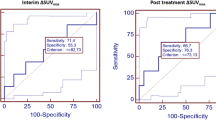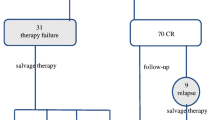Abstract
Purpose
We present the results of an investigation of the role of FDG PET in response evaluation of bulky masses in paediatric patients with Hodgkin’s lymphoma (HL) enrolled in the Italian AIEOP-LH2004 trial.
Methods
We analysed data derived from 703 patients (388 male, 315 female; mean age 13 years) with HL and enrolled in 41 different Italian centres from March 2004 to September 2012, all treated with the AIEOP-LH2004 protocol. The cohort comprised 309 patients with a bulky mass, of whom 263 were evaluated with FDG PET at baseline and after four cycles of chemotherapy. Responses were determined according to combined functional and morphological criteria. Patients were followed up for a mean period of 43 months and for each child we calculated time-to-progression (TTP) and relapse rates considering clinical monitoring, and instrumental and histological data as the reference standard. Statistical analyses were performed for FDG PET and morphological responses with respect to TTP. Multivariate analysis was used to define independent predictive factors.
Results
Overall, response evaluation revealed 238 PET-negative patients (90.5%) and 25 PET-positive patients (9.5%), with a significant difference in TTP between these groups (mean TTP: 32.67 months for negative scans, 23.8 months for positive scans; p < 0.0001, log-rank test). In the same cohort, computed tomography showed a complete response (CR) in 85 patients (32.3%), progressive disease (PD) in 6 patients (2.3%), and a partial response (PR) in 165 patients (62.7%), with a significant difference in TTP between patients with CR and patients with PD (31.1 months and 7.9 months, respectively; p < 0.001, log-rank test). Similarly, there was a significant difference in relapse rates between PET-positive and PET-negative patients (p = 0000). In patients with PR, there was also a significant difference in TTP between PET-positive and PET-negative patients (24.6 months and 34.9 months, respectively; p < 0.0001). In the multivariate analysis with correction for multiple testing, only the PET result was an independent predictive factor in both the entire cohort of patients and the subgroup showing PR on CT (p < 0.01).
Conclusion
After four cycles of chemotherapy, FDG PET response assessment in paediatric HL patients with a bulky mass is a good predictor of TTP and disease outcome. Moreover, in patients with a PR on CT, PET was able to differentiate those with a longer TTP. In paediatric HL patients with a bulky mass and in patients with a PR on CT, response on FDG PET was an independent predictive factor.





Similar content being viewed by others

References
Bar-Sever Z, Keidar Z, Ben-Barak A, Bar-Shalom R, Postovsky S, Guralnik L, et al. The incremental value of 18F-FDG PET/CT in paediatric malignancies. Eur J Nucl Med Mol Imaging. 2007;34:630–7.
Tatsumi M, Miller JH, Wahl RL. 18F-FDG PET/CT in evaluating non-CNS pediatric malignancies. J Nucl Med. 2007;48:1923–31.
Jadvar H, Connolly LP, Fahey FH, Shulkin BL. PET and PET/CT in pediatric oncology. Semin Nucl Med. 2007;37:316–31.
Meany HJ, Gidvani VK, Minniti CP. Utility of PET scans to predict disease relapse in pediatric patients with Hodgkin lymphoma. Pediatr Blood Cancer. 2007;48:399–402.
Lopci E, Burnelli R, Ambrosini V, Nanni C, Castellucci P, Biassoni L, et al. (18)F-FDG PET in pediatric lymphomas: a comparison with conventional imaging. Cancer Biother Radiopharm. 2008;23(6):681–90.
Carbone PP, Kaplan HS, Musshoff K, Smithers DW, Tubiana M. Report of the Committee on Hodgkin’s Disease Staging Classification. Cancer Res. 1971;31:1860–1.
Oberlin O. Hodgkin’s disease. In: Voûte PA, Kalifa C, Barrett A, editors. Cancer in children. Clinical management. 4th ed. New York: Oxford University; 1998. p. 137–53.
Lanzkowski P. Hodgkin’s disease. In: Lanzkowski P, editor. Manual of pediatric hematology and oncology. 3rd ed. San Diego: Academic; 1999. p. 413–43.
Hudson MM, Donaldson SS. Treatment of pediatric Hodgkin’s lymphoma. Semin Hematol. 1999;36:313–23.
Friedman DL, Chen L, Wolden S, Buxton A, McCarten K, FitzGerald TJ, et al. Dose-intensive response-based chemotherapy and radiation therapy for children and adolescents with newly diagnosed intermediate-risk Hodgkin lymphoma: a report from the Children’s Oncology Group Study AHOD0031. J Clin Oncol. 2014;32:3651–8.
Furth C, Steffen IG, Amthauer H, Ruf J, Misch D, Schönberger S, et al. Early and late therapy response assessment with [18F] fluorodeoxyglucose positron emission tomography in pediatric Hodgkin’s lymphoma: analysis of a prospective multicenter trial. J Clin Oncol. 2009;27(26):4385–91.
Bakhshi S, Bhethanabhotla S, Kumar R, Agarwal K, Sharma P, Thulkar S, et al. Posttreatment PET/CT rather than interim PET/CT using Deauville criteria predicts outcome in pediatric Hodgkin lymphoma: a prospective study comparing PET/CT with conventional imaging. J Nucl Med. 2017;58(4):577–83.
Kostakoglu L, Goldsmith SJ. Fluorine-18 fluorodeoxyglucose positron emission tomography in the staging and follow-up of lymphoma: is it time to shift gears? Eur J Nucl Med. 2000;27:1564–78.
Schöder H, Meta J, Yap C, Ariannejad M, Rao J, Phelps ME, et al. Effect of whole-body (18)FFDG PET imaging on clinical staging and management of patients with malignant lymphoma. J Nucl Med. 2001;42:1139–43.
Hoh CK, Glaspy J, Rosen P, Dahlbom M, Lee SJ, Kunkel L, et al. Whole-body FDG-PET imaging for staging of Hodgkin’s disease and lymphoma. J Nucl Med. 1997;38:343–8.
Talbot JN, Haioun C, Rain JD, Meignan M, Wioland M, Misset JL, et al. [18F]-FDG positron imaging in clinical management of lymphoma patients. Crit Rev Oncol Hematol. 2001;38:193–221.
Hueltenschmidt B, Sautter-Bihl ML, Lang O, Maul FD, Fischer J, Mergenthaler HG, et al. Whole body positron emission tomography in the treatment of Hodgkin disease. Cancer. 2001;91:302–10.
Buchmann I, Reinhardt M, Elsner K, Bunjes D, Altehoefer C, Finke J, et al. 2-(Fluorine-18)fluoro- 2-deoxy-D-glucose positron emission tomography in the detection and staging of malignant lymphoma. A bicenter trial. Cancer. 2001;91:889–99.
Moog F, Bangerter M, Diederichs CG, Guhlmann A, Kotzerke J, Merkle E, et al. Lymphoma: role of whole-body 2-deoxy-2-[F-18]fluoro-D-glucose (FDG) PET in nodal staging. Radiology. 1997;203:795–800.
Spaepen K, Stroobants S, Dupont P, Van Steenweghen S, Thomas J, Vandenberghe P, et al. Prognostic value of positron emission tomography (PET) with fluorine-18 fluorodeoxyglucose ([18F]FDG) after first-line chemotherapy in non- Hodgkin’s lymphoma: is [18F]FDG-PET a valid alternative to conventional diagnostic methods? J Clin Oncol. 2001;19:414–9.
Tatsumi M, Kitayama H, Sugahara H, Tokita N, Nakamura H, Kanakura Y, et al. Whole-body hybrid PET with 18F-FDG in the staging of non-Hodgkin’s lymphoma. J Nucl Med. 2001;42:601–8.
Canellos GP. Residual mass in lymphoma may not be residual disease. J Clin Oncol. 1988;6:931–3.
Hill M, Cunningham D, MacVicar D, Roldan A, Husband J, McCready R, et al. Role of magnetic resonance imaging in predicting relapse in residual masses after treatment of lymphoma. J Clin Oncol. 1993;11:2273–8.
Shankar A, Fiumara F, Pinkerton R. Role of FDG PET in the management of childhood lymphomas – case proven or is the jury still out? Eur J Cancer. 2008;44:663–73.
Reinhardt MJ, Herkel C, Altehoefer C, Finke J, Moser E. Computer tomography and 18F-FDG positron emission tomography for therapy control of Hodgkin’s and non-Hodgkin’s lymphoma patients: when do we really need FDG-PET? Ann Oncol. 2005;16:1524–9.
Schwartz CL, Chen L, McCarten K, Wolden S, Constine LS, Hutchison RE, et al. Childhood Hodgkin International Prognostic Score (CHIPS) predicts event-free survival in Hodgkin lymphoma: a report from the Children’s Oncology Group. Pediatr Blood Cancer. 2017;64(4):10.1002/pbc.26278.
Weihrauch MR, Re D, Scheidhauer K, Ansén S, Dietlein M, Bischoff S, et al. Thoracic positron emission tomography using 18F-fluorodeoxyglucose for the evaluation of residual mediastinal Hodgkin disease. Blood. 2001;98:2930–4.
Burnelli R, Rinieri S, Todesco A, Locatelli F, Sala A, BuffardiS, et al. Protocollo AIEOP-LH 2004 per la terapia del linfoma di Hodgkin in età pediatrica: analisi ad interim. XXXV Congresso Nazionale AIEOP, Ancona, 26–28 October 2008. Aricó M, editor. Abstract book, P044. Haematologica 2008;93 Suppl 4:S27.
Lopci E, Burnelli R, Guerra L, Cistaro A, Piccardo A, Zucchetta P, et al. Postchemotherapy PET evaluation correlates with patient outcome in paediatric Hodgkin’s disease. Eur J Nucl Med Mol Imaging. 2011;38(9):1620–7.
Cheson BD, Pfistner B, Juweid ME, Gascoyne RD, Specht L, Horning SJ, et al. Revised response criteria for malignant lymphoma. J Clin Oncol. 2007;25(5):579–86.
Juweid ME, Stroobants S, Hoekstra OS, Mottaghy FM, Dietlein M, Guermazi A, et al. Use of positron emission tomography for response assessment of lymphoma: consensus of the Imaging Subcommittee of International Harmonization Project in Lymphoma. J Clin Oncol. 2007;25(5):571–8.
Kaplan E, Meier P. Nonparametric estimation for incomplete observations. J Am Stat Assoc. 1958;53:456–81.
Cox DR. Regression models and life tables (with discussion). J R Stat Soc Ser B. 1972;34:187–220.
Sarrazin R, Dyon JF. Mediastinoscopy. Rev Mal Respir. 1992;9:99–110.
Oki Y, Chuang H, Chasen B, Jessop A, Pan T, Fanale M, et al. The prognostic value of interim positron emission tomography scan in patients with classical Hodgkin lymphoma. Br J Haematol. 2014;165(1):112–6.
Gallamini A, Hutchings M, Rigacci L, Specht L, Merli F, Hansen M, et al. Early interim 2-[18F]fluoro-2-deoxy-D-glucose positron emission tomography is prognostically superior to international prognostic score in advanced-stage Hodgkin’s lymphoma: A report from a joint Italian-Danish study. J Clin Oncol. 2007;25:3746–52.
Acknowledgments
AIEOP (Associazione Italiana di Ematologia e Oncologia Pediatrica) is acknowledged for its support of the current research. AIRC (Associazione Italiana per la Ricerca sul Cancro) is acknowledged for the fellowship support provided to Angelo Castello with the grant no. 18923.
Author information
Authors and Affiliations
Consortia
Corresponding author
Ethics declarations
Ethical approval
All procedures performed in the AIEOP-LH 2004 protocol involving human participants were in accordance with the ethical standards of the institutional and/or national research committee and with the principles of the 1964 Declaration of Helsinki and its later amendments or comparable ethical standards.
Rights and permissions
About this article
Cite this article
Lopci, E., Mascarin, M., Piccardo, A. et al. FDG PET in response evaluation of bulky masses in paediatric Hodgkin’s lymphoma (HL) patients enrolled in the Italian AIEOP-LH2004 trial. Eur J Nucl Med Mol Imaging 46, 97–106 (2019). https://doi.org/10.1007/s00259-018-4155-4
Received:
Accepted:
Published:
Issue Date:
DOI: https://doi.org/10.1007/s00259-018-4155-4



